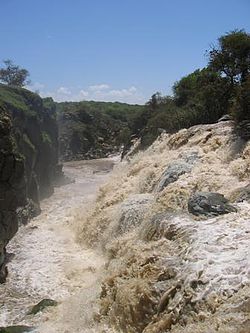
Awash River
About this schools Wikipedia selection
SOS Children volunteers helped choose articles and made other curriculum material Before you decide about sponsoring a child, why not learn about different sponsorship charities first?
| Lower Valley of the Awash | |
|---|---|
| Name as inscribed on the World Heritage List | |
 |
|
| Country | |
| Type | Cultural |
| Criteria | ii, iii, iv |
| Reference | 10 |
| UNESCO region | Africa |
| Inscription history | |
| Inscription | 1980 (4th Session) |
The Awash (sometimes spelled Hawash; Afar We'ayot) is a major river of Ethiopia. Its course is entirely contained within the boundaries of Ethiopia, and empties into a chain of interconnected lakes that begin with Lake Gargori and end with Lake Abbe (or Abhe Bad) on the border with Djibouti, some 100 kilometers (60 or 70 miles) from the head of the Gulf of Tadjoura. It is the principal stream of an endorheic drainage basin covering parts of the Amhara, Oromia and Somali Regions, as well as the southern half of the Afar Region.
Overview
The Awash rises south of Mount Warqe, west of Addis Ababa in the woreda of Ejerie, Mirab (West) Shewa Zone, Oromia. Thence the Awash flows south to loop around Mount Zuqualla in an easterly then northeasterly direction, passing the Awash National Park, and joined on its left bank by its chief affluent, the Germama (or Kasam) River, before turning northeast at approximately 11° N 40° 30' E as far north as 12° before turning completely east to reach lake Gargori.
According to materials published by the Ethiopian Central Statistical Agency, the the Awash River is 1200 kilometers long. The author of the 1911 Encyclopædia Britannica article describes its middle portion as "a copious stream nearly 200 feet [60 meters] wide and 4 feet [1.2 meters] deep in the dry season, and during the floods rising 50 or 60 feet [15 to 20 meters] above low-water mark, thus inundating the plains for many miles along both its banks."
Other tributaries of the Awash include (in order upstream): the Logiya, Mille, Borkana, Ataye, Hawadi, Kabenna and Durkham Rivers. Towns and cities along its course include Metehara, Awash, Gewane and Asaita.
History
Humans have lived in the valley of the Awash since the beginning of the species. The Middle Awash has been where numerous pre-human hominid remains have been found.
The valley of the Awash from about 9° N downstream is the traditional home of the Afar people. The valley of the Awash have been included as part of the territories of the historic provinces or kingdoms of Dawaro, Fatagar, Ifat, and Shewa. Except for Shewa, these provinces disappeared with the arrival of groups of the Oromo in the 16th century.
The first European to trace the course of the Awash to its end in the Aussa oasis was Wilfred Thesiger in 1933/1934, who started at the city of Awash, followed the river's course to its final end in Lake Abhebad, and continued his expedition west to Tadjoura. (Although the explorer L.M. Nesbitt had followed parts of the course of the Awash in 1928, he turned away from the river at Asaita and proceeded north through the Afar Depression to the Red Sea.)
In 1960, the Koka Dam was completed across the Awash River at a point about 75 kilometers from Addis Ababa, and with its opening became a major source of hydroelectric power in the area. The resulting freshwater lake, Lake Gelila (also known as the Koka Reservoir), has an area of about 180 square kilometers. Both lake and dam are threatened by increasing sedimentation.
The Awash International Bank is named for the Awash River.
